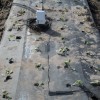 Cabbage production in Florida has been dominated by the use of seepage or sub-irrigation, because it is inexpensive to maintain and simple to use, but it can require vast quantities of water to be pumped from the aquifer in low rainfall years. Plasticulture has been proposed as an alternative production method for cabbage production in Florida. An on-farm demonstration was setup on Greene’s Farms in Bunnell, FL to provide a platform for collaboration between researchers, growers and extension professionals. This 6-page fact sheet illustrates an innovative approach converting from seepage irrigation to plasticulture and points out some options and challenges for growers considering a plasticulture system. Written by Charles E. Barrett, Lincoln Zotarelli, Brian S. Taylor, Lucas G. Paranhos, and Mark Warren, and published by the UF Department of Horticultural Sciences, July 2014.
Cabbage production in Florida has been dominated by the use of seepage or sub-irrigation, because it is inexpensive to maintain and simple to use, but it can require vast quantities of water to be pumped from the aquifer in low rainfall years. Plasticulture has been proposed as an alternative production method for cabbage production in Florida. An on-farm demonstration was setup on Greene’s Farms in Bunnell, FL to provide a platform for collaboration between researchers, growers and extension professionals. This 6-page fact sheet illustrates an innovative approach converting from seepage irrigation to plasticulture and points out some options and challenges for growers considering a plasticulture system. Written by Charles E. Barrett, Lincoln Zotarelli, Brian S. Taylor, Lucas G. Paranhos, and Mark Warren, and published by the UF Department of Horticultural Sciences, July 2014.
http://edis.ifas.ufl.edu/hs1246
Tag: Mark Warren
Controlled-Release Fertilizers for Potato Production in Florida (HS941/HS187)
 The recent emphasis on the development of vegetable production best management practices has prompted a re-examination of fertilization practices in Florida potato production in the St. Johns River watershed. The numbers provided in this 5-page fact sheet serve as a starting point for discussion about the value of using controlled-release fertilizers, which can be a win-win-win opportunity for producers, manufacturers, and regulatory agencies by helping all meet their production, business, and environmental goals. Written by Guodong Liu, Eric H. Simonne, Yuncong Li, Chad M. Hutchinson, Mark Warren, and Steven Lands, and published by the UF Department of Horticultural Sciences, October 2011. (UF/IFAS Photo by Tyler Jones)
The recent emphasis on the development of vegetable production best management practices has prompted a re-examination of fertilization practices in Florida potato production in the St. Johns River watershed. The numbers provided in this 5-page fact sheet serve as a starting point for discussion about the value of using controlled-release fertilizers, which can be a win-win-win opportunity for producers, manufacturers, and regulatory agencies by helping all meet their production, business, and environmental goals. Written by Guodong Liu, Eric H. Simonne, Yuncong Li, Chad M. Hutchinson, Mark Warren, and Steven Lands, and published by the UF Department of Horticultural Sciences, October 2011. (UF/IFAS Photo by Tyler Jones)
http://edis.ifas.ufl.edu/hs187
Converting the Beef Cow Herd to a Controlled Breeding Season (AN267)
 Implementing a controlled breeding season to manage the length of the calving season is a cost-effective management practice. This 4-page fact sheet describes a 3- to 4-year conversion program beef cattle producers can follow. Written by Tim Wilson, Cindy Sanders, Mark Warren, Matt Hersom, and Curt Lacy, and published by the UF Department of Animal Science, August 2011.
Implementing a controlled breeding season to manage the length of the calving season is a cost-effective management practice. This 4-page fact sheet describes a 3- to 4-year conversion program beef cattle producers can follow. Written by Tim Wilson, Cindy Sanders, Mark Warren, Matt Hersom, and Curt Lacy, and published by the UF Department of Animal Science, August 2011.
http://edis.ifas.ufl.edu/an267
AN244 Winter Feed Estimator: A Practical Tool for the Beef Cow-Calf Producer
AN244, a 3-page fact sheet by Mark Warren, Ed Jennings, and Matt Hersom, provides a simple approach for estimating dry matter feed requirements of the beef herd and then converting those requirements into an estimate of required hay or silage round rolls. Published by the UF Department of Animal Science, June 2010.
http://edis.ifas.ufl.edu/an244